 | ÐлекÑÑоннÑй компоненÑ: AD6644ST | СкаÑаÑÑ:  PDF PDF  ZIP ZIP |
Äîêóìåíòàöèÿ è îïèñàíèÿ www.docs.chipfind.ru
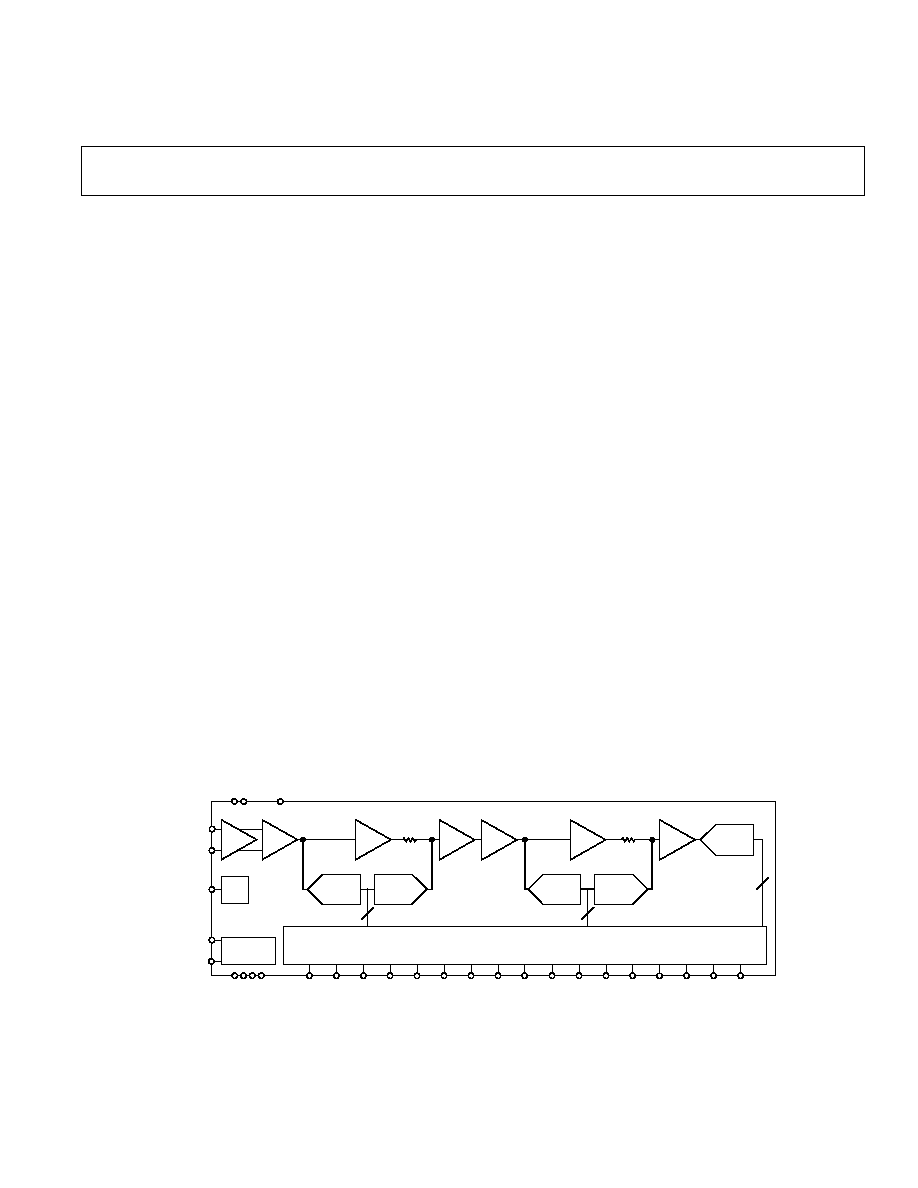
REV. 0
Information furnished by Analog Devices is believed to be accurate and
reliable. However, no responsibility is assumed by Analog Devices for its
use, nor for any infringements of patents or other rights of third parties
which may result from its use. No license is granted by implication or
otherwise under any patent or patent rights of Analog Devices.
a
AD6644
One Technology Way, P.O. Box 9106, Norwood, MA 02062-9106, U.S.A.
Tel: 781/329-4700
World Wide Web Site: http://www.analog.com
Fax: 781/326-8703
© Analog Devices, Inc., 2000
14-Bit, 40 MSPS/65 MSPS
A/D Converter
FUNCTIONAL BLOCK DIAGRAM
5
ADC2
DAC2
TH4
TH3
TH5
ADC3
6
A2
5
ADC1
DAC1
TH2
TH1
A1
DIGITAL
ERROR
CORRECTION
LOGIC
2.4V
INTERNAL
TIMING
AV
CC
DV
CC
AIN
AIN
V
REF
ENCODE
ENCODE
GND
D8
D9
D10
D11
D12
D13
DRY
OVR
DMID
D0
D1
D2
D3
D4
D5
D6
D7
MSB
LSB
AD6644
FEATURES
65 MSPS Guaranteed Sample Rate
40 MSPS Version Available
Sampling Jitter < 300 fs
100 dB Multitone SFDR
1.3 W Power Dissipation
Differential Analog Inputs
Digital Outputs
Two's Complement Format
3.3 V CMOS-Compatible
Data Ready for Output Latching
APPLICATIONS
Multichannel, Multimode Receivers
AMPS, IS-136, CDMA, GSM, Third Generation
Single Channel Digital Receivers
Antenna Array Processing
Communications Instrumentation
Radar, Infrared Imaging
Instrumentation
PRODUCT DESCRIPTION
The AD6644 is a high-speed, high-performance, monolithic
14-bit analog-to-digital converter. All necessary functions,
including track-and-hold (T/H) and reference, are included on-
chip to provide a complete conversion solution. The AD6644
provides CMOS-compatible digital outputs. It is the third genera-
tion in a wideband ADC family, preceded by the AD9042 (12-bit
41 MSPS) and the AD6640 (12-bit 65 MSPS, IF sampling.)
Designed for multichannel, multimode receivers, the AD6644 is
part of ADI's new SoftCellTM transceiver chipset. The AD6644
achieves 100 dB multitone, spurious-free dynamic range (SFDR)
through the Nyquist band. This breakthrough performance eases
the burden placed on multimode digital receivers (software radios)
which are typically limited by the ADC. Noise performance is
exceptional; typical signal-to-noise ratio is 74 dB.
The AD6644 is also useful in single channel digital receivers
designed for use in wide-channel bandwidth systems (CDMA,
W-CDMA). With oversampling, harmonics can be placed out-
side the analysis bandwidth. Oversampling also facilitates the use of
decimation receivers (such as the AD6620), allowing the noise
floor in the analysis bandwidth to be reduced. By replacing tradi-
tional analog filters with predictable digital components, modern
receivers can be built using fewer "RF" components, resulting
in decreased manufacturing costs, higher manufacturing yields,
and improved reliability.
The AD6644 is built on Analog Devices' high-speed complemen-
tary bipolar process (XFCB) and uses an innovative, multipass
circuit architecture. Units are packaged in a 52-terminal Low-
Profile Quad Plastic Flatpack (LQFP) specified from 25
°C
to +85
°C.
PRODUCT HIGHLIGHTS
1. Guaranteed sample rate is 65 MSPS.
2. Fully differential analog input stage.
3. Digital outputs may be run on 3.3 V supply for easy interface
to digital ASICs.
4. Complete Solution: reference and track-and-hold.
5. Packaged in small, surface-mount, plastic, 52-terminal LQFP.
SoftCell is a trademark of Analog Devices, Inc.
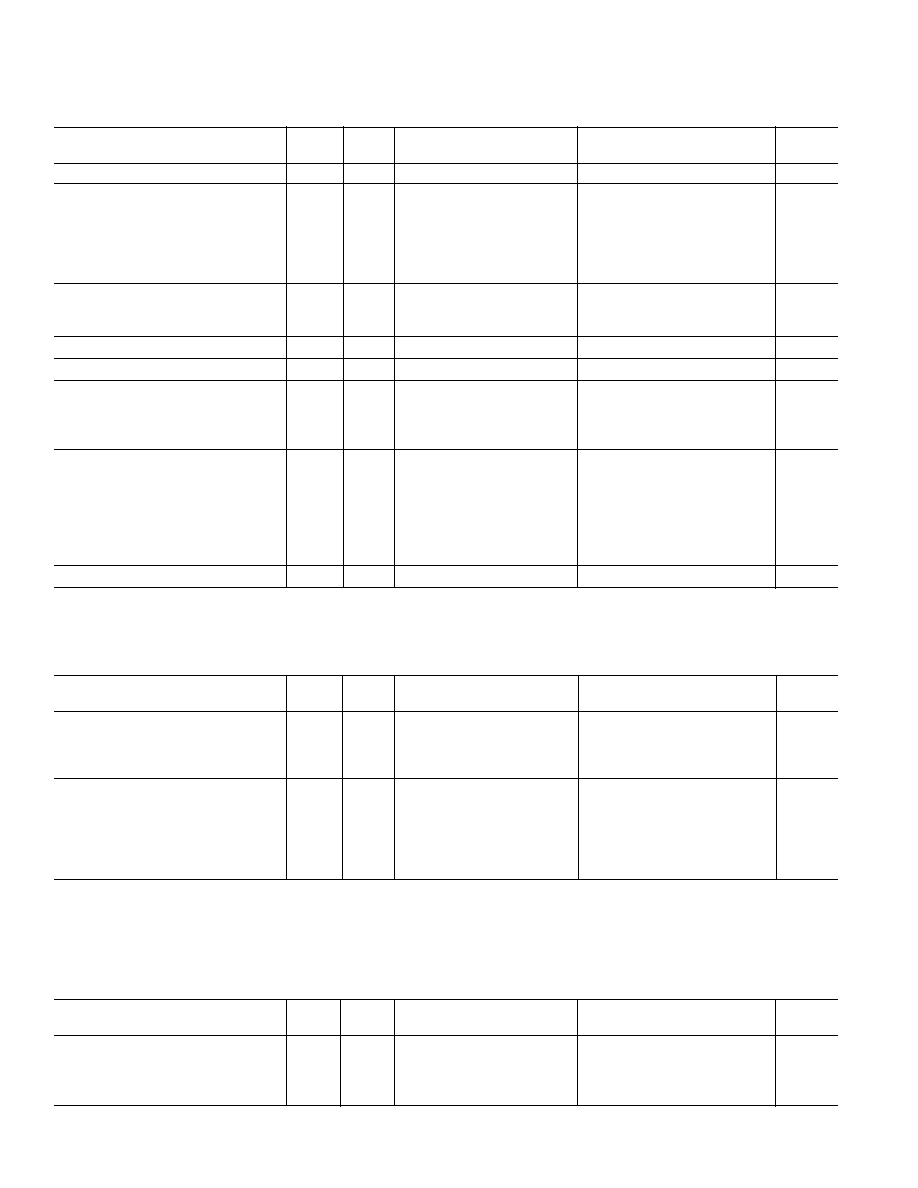
2
REV. 0
AD6644SPECIFICATIONS
DC SPECIFICATIONS
Test
AD6644AST-40
AD6644AST-65
Parameter
Temp
Level
Min
Typ
Max
Min
Typ
Max
Unit
RESOLUTION
14
14
Bits
ACCURACY
No Missing Codes
Full
II
Guaranteed
Guaranteed
Offset Error
Full
II
10
3
+10
10
3
+10
mV
Gain Error
Full
II
10
6
+10
10
6
+10
% FS
Differential Nonlinearity (DNL)
Full
II
1.0
±0.25
+1.5
1.0
±0.25
+1.5
LSB
Integral Nonlinearity (INL)
Full
V
±0.50
±0.50
LSB
TEMPERATURE DRIFT
Offset Error
Full
V
10
10
ppm/
°C
Gain Error
Full
V
95
95
ppm/
°C
POWER SUPPLY REJECTION (PSRR)
Full
V
±1.0
±1.0
mV/V
REFERENCE OUT (V
REF
)
Full
V
2.4
2.4
V
ANALOG INPUTS (AIN, AIN)
Differential Input Voltage Range
Full
V
2.2
2.2
V p-p
Differential Input Resistance
Full
V
1
1
k
Differential Input Capacitance
25
°C
V
1.5
1.5
pF
POWER SUPPLY
Supply Voltage
AV
CC
1
Full
II
4.85
5.0
5.25
4.85
5.0
5.25
V
DV
CC
Full
II
3.0
3.3
3.6
3.0
3.3
3.6
V
Supply Current
IA
VCC
(AV
CC
= 5.0 V)
Full
II
245
276
245
276
mA
ID
VCC
(DV
CC
= 3.3 V)
Full
II
30
36
30
36
mA
POWER CONSUMPTION
Full
II
1.3
1.5
1.3
1.5
W
NOTES
1
AV
CC
may be varied from 4.85 V to 5.25 V. However, rated ac (harmonics) performance is valid only over the range AV
CC
= 5.0 V to 5.25 V.
Specifications subject to change without notice.
DIGITAL SPECIFICATIONS
Test
AD6644AST-40
AD6644AST-65
Parameter
Temp
Level
Min
Typ
Max
Min
Typ
Max
Unit
ENCODE INPUTS (ENC, ENC)
Differential Input Voltage
1
Full
IV
0.4
0.4
V p-p
Differential Input Resistance
25
°C
V
10
10
k
Differential Input Capacitance
25
°C
V
2.5
2.5
pF
LOGIC OUTPUTS (D13D0, DRY, OVR)
Logic Compatibility
CMOS
CMOS
Logic "1" Voltage
2
Full
V
2.5
2.5
V
Logic "0" Voltage
2
Full
V
0.4
0.4
V
Output Coding
Two's Complement
Two's Complement
DMID
Full
V
DV
CC
/2
DV
CC
/2
V
NOTES
1
All ac specifications tested by driving ENCODE and ENCODE differentially. Reference Figure 22 for performance versus encode power.
2
Digital output logic levels: DV
CC
= 3.3 V, C
LOAD
= 10 pF. Capacitive loads >10 pF will degrade performance.
Specifications subject to change without notice.
SWITCHING SPECIFICATIONS
Test
AD6644AST-40
AD6644AST-65
Parameter
Temp
Level
Min
Typ
Max
Min
Typ
Max
Unit
Maximum Conversion Rate
Full
II
40
65
MSPS
Minimum Conversion Rate
Full
IV
15
15
MSPS
ENCODE Pulsewidth High
Full
IV
10
6.5
ns
ENCODE Pulsewidth Low
Full
IV
10
6.5
ns
Specifications subject to change without notice.
(AV
CC
= 5 V, DV
CC
= 3.3 V; T
MIN
= 25 C, T
MAX
= +85 C)
(AV
CC
= 5 V, DV
CC
= 3.3 V; T
MIN
= 25 C, T
MAX
= +85 C)
(AV
CC
= 5 V, DV
CC
= 3.3 V; ENCODE and ENCODE = Maximum Conversion Rate MSPS; T
MIN
=
25 C, T
MAX
= +85 C)
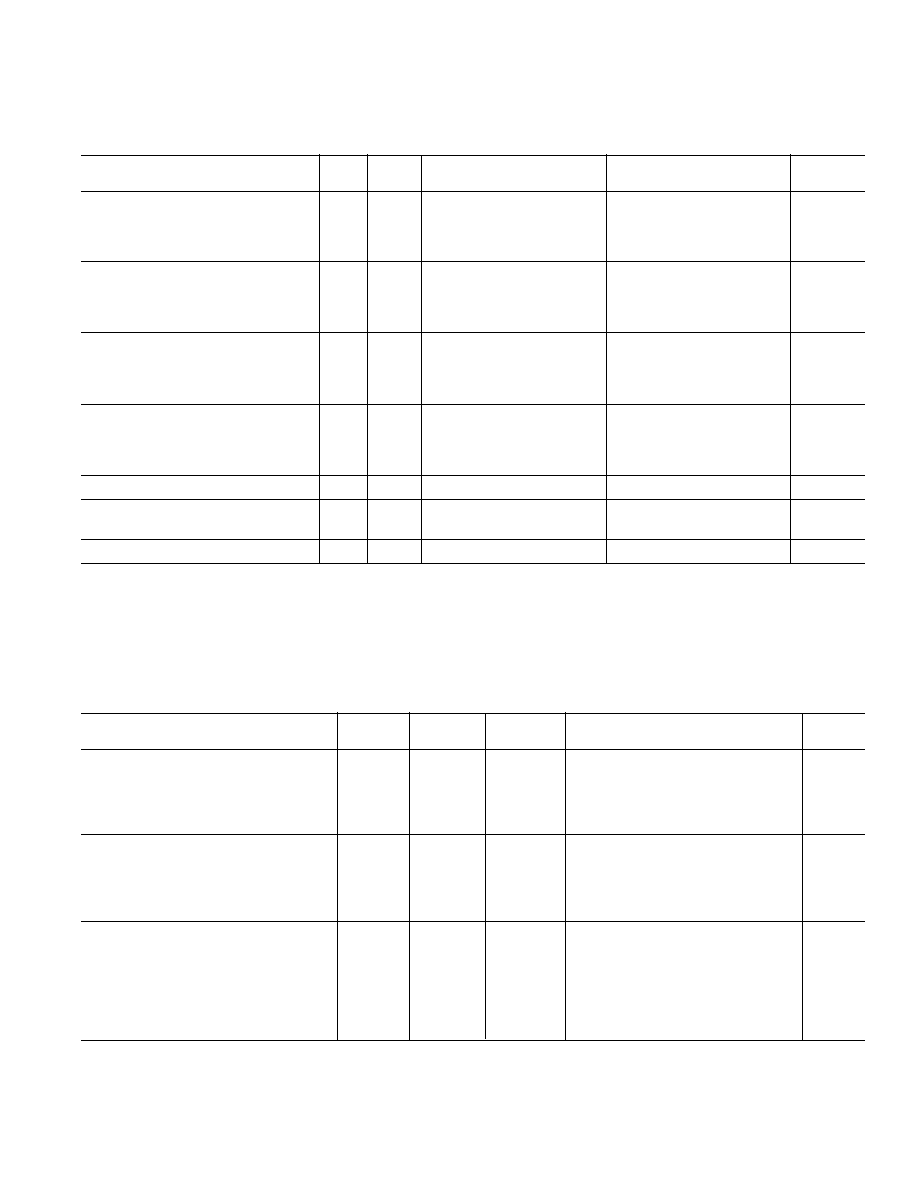
3
REV. 0
AD6644
AC SPECIFICATIONS
1
Test
AD6644AST-40
AD6644AST-65
Parameter
Temp
Level
Min
Typ
Max
Min
Typ
Max
Unit
SNR
Analog Input
2.2 MHz
25
°C
II
74.5
72
74.5
dB
@ 1 dBFS
15.5 MHz
25
°C
II
74.0
72
74.0
dB
30.5 MHz
25
°C
II
73.5
72
73.5
dB
SINAD
2
Analog Input
2.2 MHz
25
°C
II
74.5
72
74.5
dB
@ 1 dBFS
15.5 MHz
25
°C
II
74.0
72
74.0
dB
30.5 MHz
25
°C
V
73.0
73.0
dB
WORST HARMONIC
(2
ND
or 3
RD
)
2
Analog Input
2.2 MHz
25
°C
II
92
83
92
dBc
@ 1 dBFS
15.5 MHz
25
°C
II
90
83
90
dBc
30.5 MHz
25
°C
V
85
85
dBc
WORST HARMONIC (4
TH
or Higher)
2
Analog Input
2.2 MHz
25
°C
II
93
85
93
dBc
@ 1 dBFS
15.5 MHz
25
°C
II
92
85
92
dBc
30.5 MHz
25
°C
V
92
92
dBc
TWO-TONE SFDR
2,
3, 4
Full
V
100
100
dBFS
TWO-TONE IMD REJECTION
2, 4
F1, F2 @ 7 dBFS
Full
V
90
90
dBc
ANALOG INPUT BANDWIDTH
25
°C
V
250
250
MHz
NOTES
1
All ac specifications tested by driving ENCODE and ENCODE differentially.
2
AV
CC
= 5 V to 5.25 V for rated ac performance.
3
Analog input signal power swept from 7 dBFS to 100 dBFS.
4
F1 = 15 MHz, F2 = 15.5 MHz.
Specifications subject to change without notice.
SWITCHING SPECIFICATIONS
Test
AD6644AST-40/65
Parameter
Name
Temp
Level
Min
Typ
Max
Unit
ENCODE INPUT PARAMETERS
1
Encode Period
1
@ 65 MSPS
t
ENC
Full
V
15.4
ns
Encode Period
1
@ 40 MSPS
t
ENC
Full
V
25
ns
Encode Pulsewidth High
2
@ 65 MSPS
t
ENCH
Full
IV
6.2
7.7
9.2
ns
Encode Pulsewidth Low @ 65 MSPS
t
ENCL
Full
IV
6.2
7.7
9.2
ns
ENCODE/DATA READY
Encode Rising to Data Ready Falling
t
DR
Full
IV
2.6
3.4
4.6
ns
Encode Rising to Data Ready Rising
t
E_DR
t
ENCH
+ t
DR
@ 65 MSPS (50% Duty Cycle)
Full
IV
10.3
11.1
12.3
ns
@ 40 MSPS (50% Duty Cycle)
Full
IV
15.1
15.9
17.1
ns
ENCODE/DATA (D13:0), OVR
ENC to DATA Falling Low
t
E_FL
Full
IV
3.8
5.5
9.2
ns
ENC to DATA Rising Low
t
E_RL
Full
IV
3.0
4.3
6.4
ns
ENCODE to DATA Delay (Hold Time)
3
t
H_E
Full
IV
3.0
4.3
6.4
ns
ENCODE to DATA Delay (Setup Time)
4
t
S_E
t
ENC
t
E_FL
Encode = 65 MSPS (50% Duty Cycle)
Full
IV
6.2
9.8
11.6
ns
Encode = 40 MSPS (50% Duty Cycle)
Full
IV
15.9
19.4
21.2
ns
(AV
CC
= 5 V, DV
CC
= 3.3 V; ENCODE and ENCODE = Maximum Conversion Rate MSPS; T
MIN
= 25 C, T
MAX
= +85 C)
(AV
CC
= 5 V, DV
CC
= 3.3 V; ENCODE and ENCODE = Maximum Conversion Rate MSPS; T
MIN
=
25 C, T
MAX
= +85 C, C
LOAD
= 10 pF)

4
REV. 0
AD6644SPECIFICATIONS
ENC,
ENC
D[13:0], OVR
DRY
N1
t
H_DR
t
S_DR
N
N2
N3
t
S_E
t
H_E
t
E_DR
t
E_FL
t
E_RL
t
ENC
t
ENCH
t
ENCL
N 1
N
N 2
N 3
N 4
t
A
N
AIN
N 1
N 2
N 3
N 4
t
DR
Figure 1. Timing Diagram
Test
AD6644AST-40/65
Parameter
Name
Temp
Level
Min
Typ
Max
Unit
DATA READY (DRY
5
)/DATA, OVR
Data Ready to DATA Delay (Hold Time)
2
t
H_DR
Note 6
Encode = 65 MSPS (50% Duty Cycle)
Full
IV
8.0
8.6
9.4
ns
Encode = 40 MSPS (50% Duty Cycle)
Full
IV
12.8
13.4
14.2
ns
Data Ready to DATA Delay (Setup Time)
2
t
S_DR
Note 6
@ 65 MSPS (50% Duty Cycle)
Full
IV
3.2
5.5
6.5
ns
@ 40 MSPS (50% Duty Cycle)
Full
IV
8.0
10.3
11.3
ns
APERTURE DELAY
t
A
25
°C
V
100
ps
APERTURE UNCERTAINTY (JITTER)
t
J
25
°C
V
0.2
ps rms
NOTES
1
Several timing parameters are a function of t
ENC
and t
ENCH
.
2
To compensate for a change in duty cycle for t
H_DR
and t
S_DR
use the following equation:
Newt
H_DR
= (t
H_DR
% Change(t
ENCH
))
× t
ENC
/2
Newt
S_DR
= (t
S_DR
% Change(t
ENCH
))
× t
ENC
/2.
3
ENCODE to DATA Delay (Hold Time) is the absolute minimum propagation delay through the analog-to-digital converter.
4
ENCODE to DATA Delay (Setup Time) is calculated relative to 65 MSPS (50% duty cycle). In order to calculate t
S_E
for a given encode use the following equation:
Newt
S_E
= t
ENC(NEW)
t
ENC
+ t
S_E
(i.e., for 40 MSPS: Newt
S_E(TYP)
= 25
× 10
9
15.38
× 10
9
+ 9.8
× 10
9
= 19.4
× 10
9
).
5
DRY is an inverted and delayed version of the encode clock. Any change in the duty cycle of the clock will correspondingly change the duty cycle of DRY.
6
Data Ready to DATA Delay(t
H_DR
and t
S_DR
) is calculated relative to 65 MSPS (50% duty cycle) and is dependent on t
ENC
and duty cycle. In order to calculate t
H_DR
and t
S_DR
for a given encode use the following equations:
Newt
H_DR
= t
ENC(NEW)
/2 t
ENCH
+ t
H_DR
(i.e., for 40 MSPS: Newt
H_DR(TYP)
= 12.5
× 10
9
7.69
× 10
9
+ 8.6
× 10
9
= 13.4
× 10
9
Newt
S_DR
= t
ENC(NEW)
/2 t
ENCH
+ t
S_DR
(i.e., for 40 MSPS: Newt
S_DR(TYP)
= 12.5
× 10
9
7.69
× 10
9
+ 5.5
× 10
9
= 10.3
× 10
9
.
Specifications subject to change without notice.
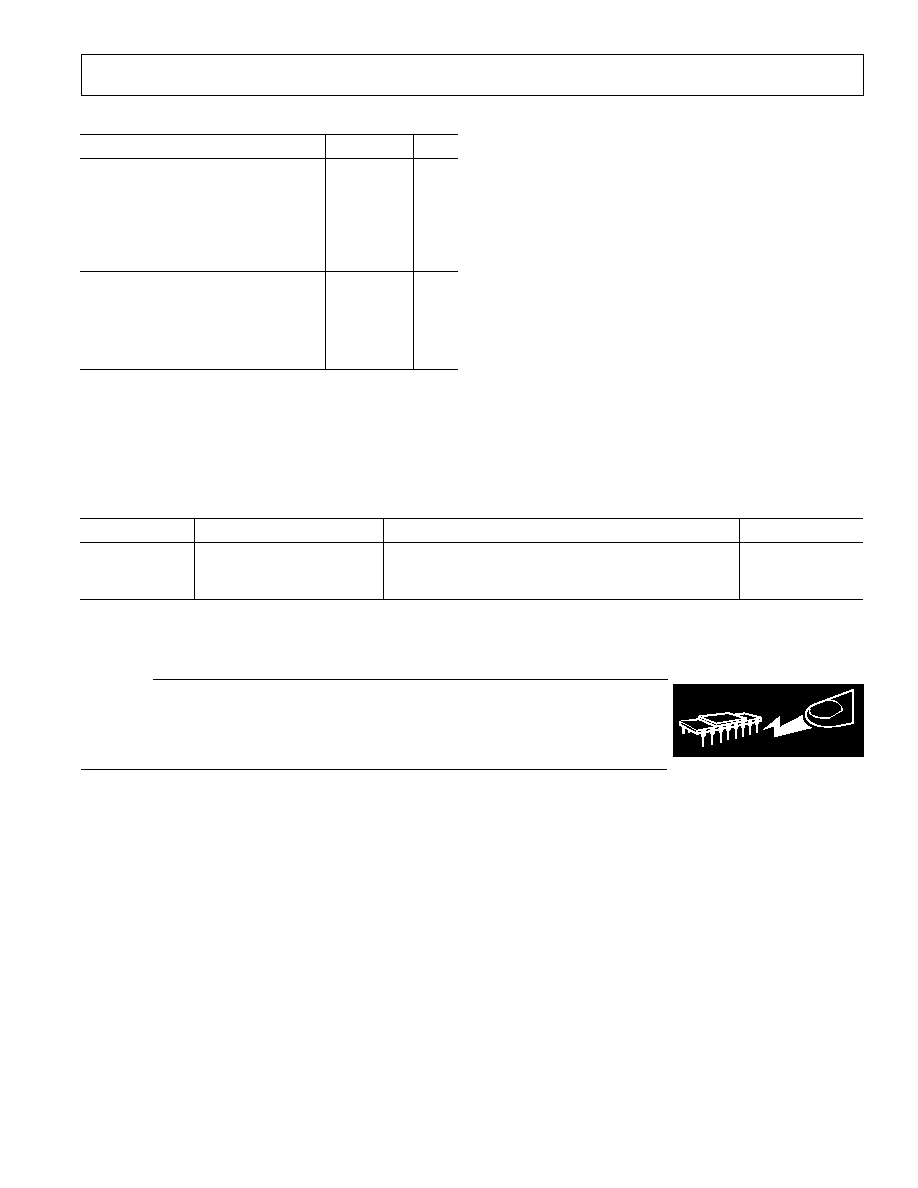
AD6644
5
REV. 0
ABSOLUTE MAXIMUM RATINGS
1
Parameter
Min
Max
Unit
ELECTRICAL
AV
CC
Voltage
0
7
V
DV
CC
Voltage
0
7
V
Analog Input Voltage
0
AV
CC
V
Analog Input Current
25
mA
Digital Input Voltage
0
AV
CC
V
Digital Output Current
4
mA
ENVIRONMENTAL
2
Operating Temperature Range
(Ambient)
25
+85
°C
Maximum Junction Temperature
150
°C
Lead Temperature (Soldering, 10 sec)
300
°C
Storage Temperature Range (Ambient)
65
+150
°C
NOTES
1
Absolute maximum ratings are limiting values to be applied individually, and
beyond which the serviceability of the circuit may be impaired. Functional
operability is not necessarily implied. Exposure to absolute maximum rating
conditions for an extended period of time may affect device reliability.
2
Typical thermal impedances (52-terminal LQFP);
JA
= 33
°C/W;
JC
= 11
°C/W.
These measurements were taken on a 6 layer board in still air with a solid ground
plane.
EXPLANATION OF TEST LEVELS
Test Level
I
100% production tested.
II
100% production tested at 25
°C, and guaranteed by
design and characterization at temperature extremes.
III Sample tested only.
IV Parameter is guaranteed by design and characterization
testing.
V
Parameter is a typical value only.
ORDERING GUIDE
Model
Temperature Range
Package Description
Package Option
AD6644AST-40
25
°C to +85°C (Ambient)
52-Terminal LQFP (Low-Profile Quad Plastic Flatpack)
ST-52
AD6644AST-65
25
°C to +85°C (Ambient)
52-Terminal LQFP (Low-Profile Quad Plastic Flatpack)
ST-52
AD6644ST/PCB
Evaluation Board with AD6644AST65
CAUTION
ESD (electrostatic discharge) sensitive device. Electrostatic charges as high as 4000 V readily
accumulate on the human body and test equipment and can discharge without detection. Although
the AD6644 features proprietary ESD protection circuitry, permanent damage may occur on devices
subjected to high-energy electrostatic discharges. Therefore, proper ESD precautions are recom-
mended to avoid performance degradation or loss of functionality.
WARNING!
ESD SENSITIVE DEVICE
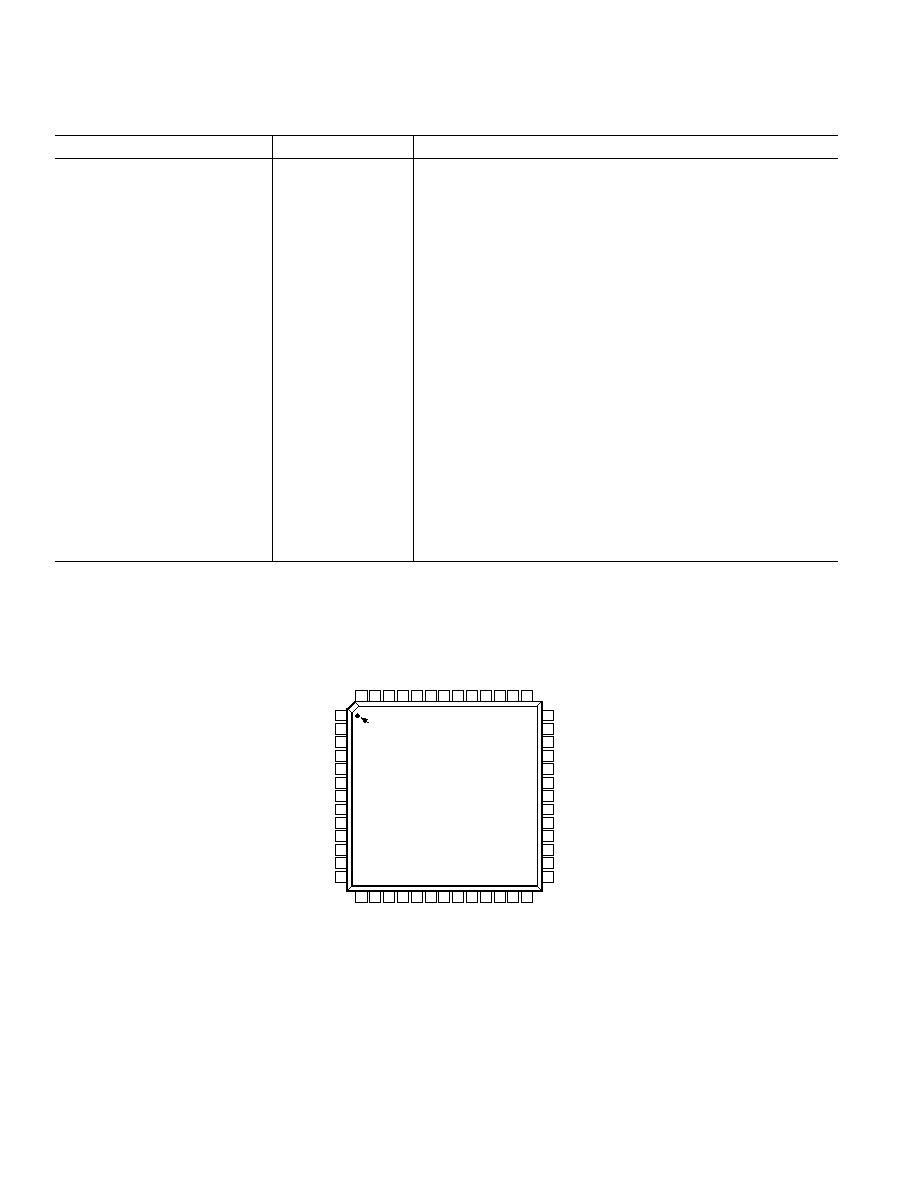
AD6644
6
REV. 0
PIN FUNCTION DESCRIPTIONS
Pin No.
Name
Function
1, 33, 43
DV
CC
3.3 V Power Supply (Digital) Output Stage Only.
2, 4, 7, 10, 13, 15, 17, 19, 21, 23,
GND
Ground.
25, 27, 29, 34, 42
3
V
REF
2.4 V (Analog Reference). Bypass to ground with 0.1
µF microwave
chip capacitor.
5
ENCODE
Encode Input; conversion initiated on rising edge.
6
ENCODE
Complement of ENCODE; differential input.
8, 9, 14, 16, 18, 22, 26, 28, 30
AV
CC
5 V Analog Power Supply.
11
AIN
Analog Input.
12
AIN
Complement of AIN; Differential Analog Input.
20
C1
Internal Voltage Reference; bypass to ground with 0.1
µF microwave
chip capacitor.
24
C2
Internal Voltage Reference; bypass to ground with 0.1
µF microwave
chip capacitor.
31
DNC
Do not connect this pin.
32
OVR
Overrange Bit; high indicates analog input exceeds
±FS.
35
DMID
Output Data Voltage Midpoint; approximately equal to (DVCC)/2.
36
D0 (LSB)
Digital Output Bit (Least Significant Bit); Two's Complement
3741, 4450
D1D5, D6D12
Digital Output Bits in Two's Complement.
51
D13 (MSB)
Digital Output Bit (Most Significant Bit); Two's Complement.
52
DRY
Data Ready Output.
PIN CONFIGURATION
40
41
42
43
44
45
46
47
48
49
50
51
52
14 15 16 17 18 19 20 21 22 23 24 25 26
1
2
3
4
5
6
7
8
9
10
11
12
13
27
28
29
30
31
32
33
34
35
36
37
38
39
PIN 1
IDENTIFIER
TOP VIEW
(Not to Scale)
DNC = DO NOT CONNECT
DRY
D13 (MSB)
D12
D11
D10
D9
D8
D7
D6
DV
CC
GND
D5
D4
DV
CC
GND
V
REF
GND
ENCODE
ENCODE
GND
AV
CC
AV
CC
GND
AIN
AIN
GND
D3
D2
D1
D0 (LSB)
DMID
GND
DV
CC
OVR
DNC
AV
CC
GND
AV
CC
GND
AV
CC
GND
AV
CC
GND
AV
CC
GND
C1
GND
AV
CC
GND
GND
AV
CC
C2
AD6644

AD6644
7
REV. 0
DEFINITIONS OF SPECIFICATIONS
Analog Bandwidth
The analog input frequency at which the spectral power of the
fundamental frequency (as determined by the FFT analysis) is
reduced by 3 dB.
Aperture Delay
The delay between the 50% point of the rising edge of the
ENCODE command and the instant at which the analog input
is sampled.
Aperture Uncertainty (Jitter)
The sample-to-sample variation in aperture delay.
Differential Analog Input Resistance, Differential Analog Input
Capacitance, and Differential Analog Input Impedance
The real and complex impedances measured at each analog
input port. The resistance is measured statically and the capaci-
tance and differential input impedances are measured with a
network analyzer.
Differential Analog Input Voltage Range
The peak-to-peak differential voltage that must be applied to the
converter to generate a full-scale response. Peak differential voltage
is computed by observing the voltage on a single pin and sub-
tracting the voltage from the other pin, which is 180 degrees out
of phase. Peak-to-peak differential is computed by rotating the
inputs phase 180 degrees and taking the peak measurement again.
The difference is then computed between both peak measurements.
Differential Nonlinearity
The deviation of any code width from an ideal 1 LSB step.
Encode Pulsewidth/Duty Cycle
Pulsewidth high is the minimum amount of time that the
ENCODE pulse should be left in Logic 1 state to achieve rated
performance; pulsewidth low is the minimum time ENCODE
pulse should be left in low state. See timing implications of
changing t
ENCH
in text. At a given clock rate, these specs define
an acceptable ENCODE duty cycle.
Full-Scale Input Power
Expressed in dBm. Computed using the following equation:
Power
V
Z
Full Scale
Full Scale rms
Input
=
10
0 001
2
log
| |
.
Harmonic Distortion, 2nd
The ratio of the rms signal amplitude to the rms value of the
second harmonic component, reported in dBc.
Harmonic Distortion, 3rd
The ratio of the rms signal amplitude to the rms value of the
third harmonic component, reported in dBc.
Integral Nonlinearity
The deviation of the transfer function from a reference line
measured in fractions of 1 LSB using a "best straight line"
determined by a least-square curve fit.
Minimum Conversion Rate
The encode rate at which the SNR of the lowest analog signal
frequency drops by no more than 3 dB below the guaranteed limit.
Maximum Conversion Rate
The encode rate at which parametric testing is performed.
Output Propagation Delay
The delay between a differential crossing of ENCODE and
ENCODE and the time when all output data bits are within
valid logic levels.
Noise (For Any Range Within the ADC)
V
Z
NOISE
FS
Signal
dBm
dBFS
=
×
×
| |
.
0 001 10
10
Where Z is the input impedance, FS is the full scale of the device
for the frequency in question, SNR is the value for the particular
input level and Signal is the signal level within the ADC reported
in dB below full scale. This value includes both thermal and
quantization noise.
Power Supply Rejection Ratio
The ratio of a change in input offset voltage to a change in power
supply voltage.
Signal-to-Noise-and-Distortion (SINAD)
The ratio of the rms signal amplitude (set 1 dB below full scale)
to the rms value of the sum of all other spectral components,
including harmonics, but excluding dc.
Signal-to-Noise Ratio (Without Harmonics)
The ratio of the rms signal amplitude (set at 1 dB below full scale)
to the rms value of the sum of all other spectral components,
excluding the first five harmonics and dc.
Spurious-Free Dynamic Range (SFDR)
The ratio of the rms signal amplitude to the rms value of the peak
spurious spectral component. The peak spurious component may
or may not be a harmonic. May be reported in dBc (i.e., degrades
as signal level is lowered), or dBFS (always related back to con-
verter full scale).
Two-Tone Intermodulation Distortion Rejection
The ratio of the rms value of either input tone to the rms value
of the worst third order intermodulation product; reported in dBc.
Two-Tone SFDR
The ratio of the rms value of either input tone to the rms value
of the peak spurious component. The peak spurious component
may or may not be an IMD product. May be reported in dBc
(i.e., degrades as signal level is lowered), or in dBFS (always
related back to converter full scale).
Worst Other Spur
The ratio of the rms signal amplitude to the rms value of the worst
spurious component (excluding the 2nd and 3rd harmonic)
reported in dBc.
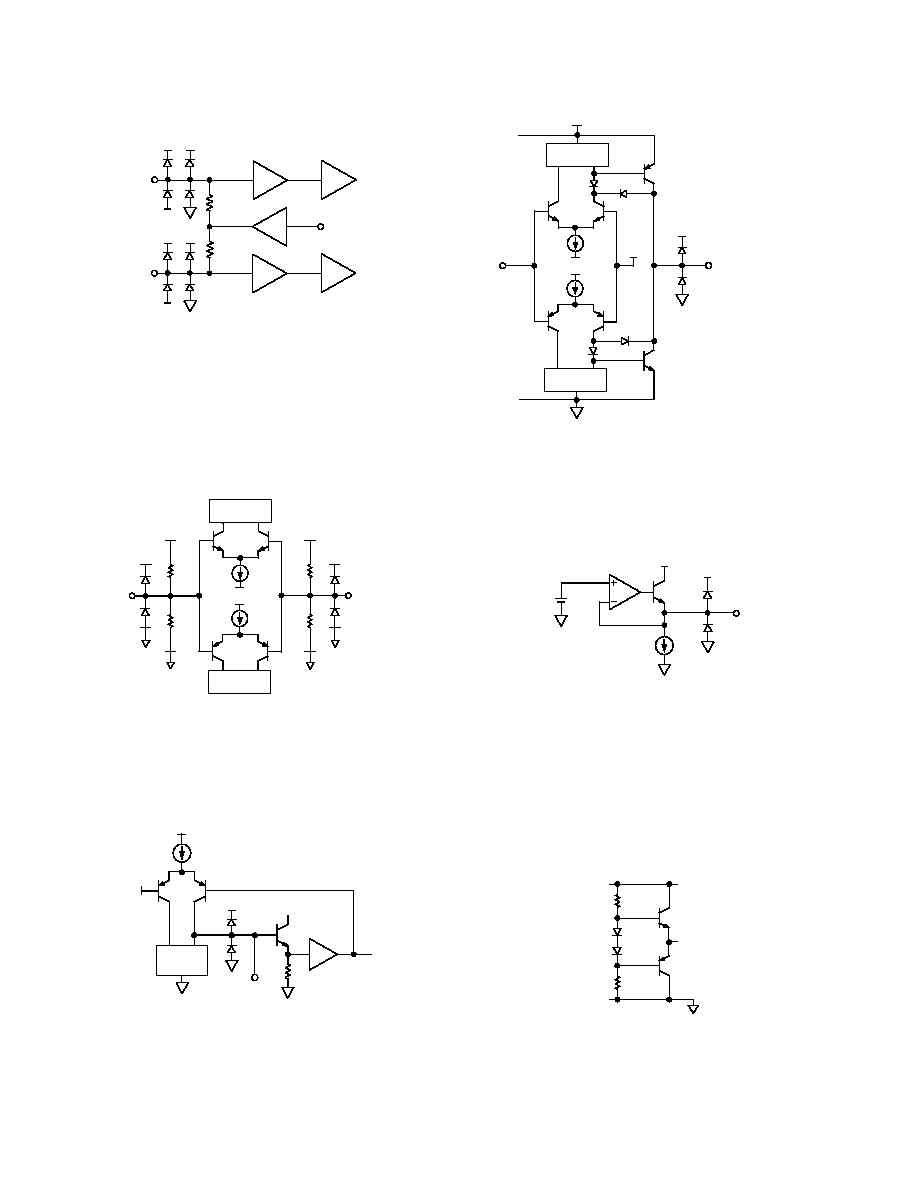
AD6644
8
REV. 0
EQUIVALENT CIRCUITS
500
BUF
BUF
500
BUF
AIN
AIN
V
REF
AV
CC
V
CH
AV
CC
V
CH
V
CL
V
CL
T/H
T/H
Figure 2. Analog Input Stage
LOADS
LOADS
10k
10k
ENCODE
10k
10k
ENCODE
AV
CC
AV
CC
AV
CC
AV
CC
Figure 3. ENCODE Inputs
AV
CC
AV
CC
C1 OR C2
CURRENT
MIRROR
V
REF
AV
CC
Figure 4. Compensation Pin, C1 or C2
V
REF
DV
CC
DV
CC
CURRENT
MIRROR
D0D13, OVR, DRY
CURRENT
MIRROR
Figure 5. Digital Output Stage
V
REF
AV
CC
100 A
2.4V
AV
CC
Figure 6. 2.4 V Reference
10k
DMID
10k
DV
CC
Figure 7. DMID Reference
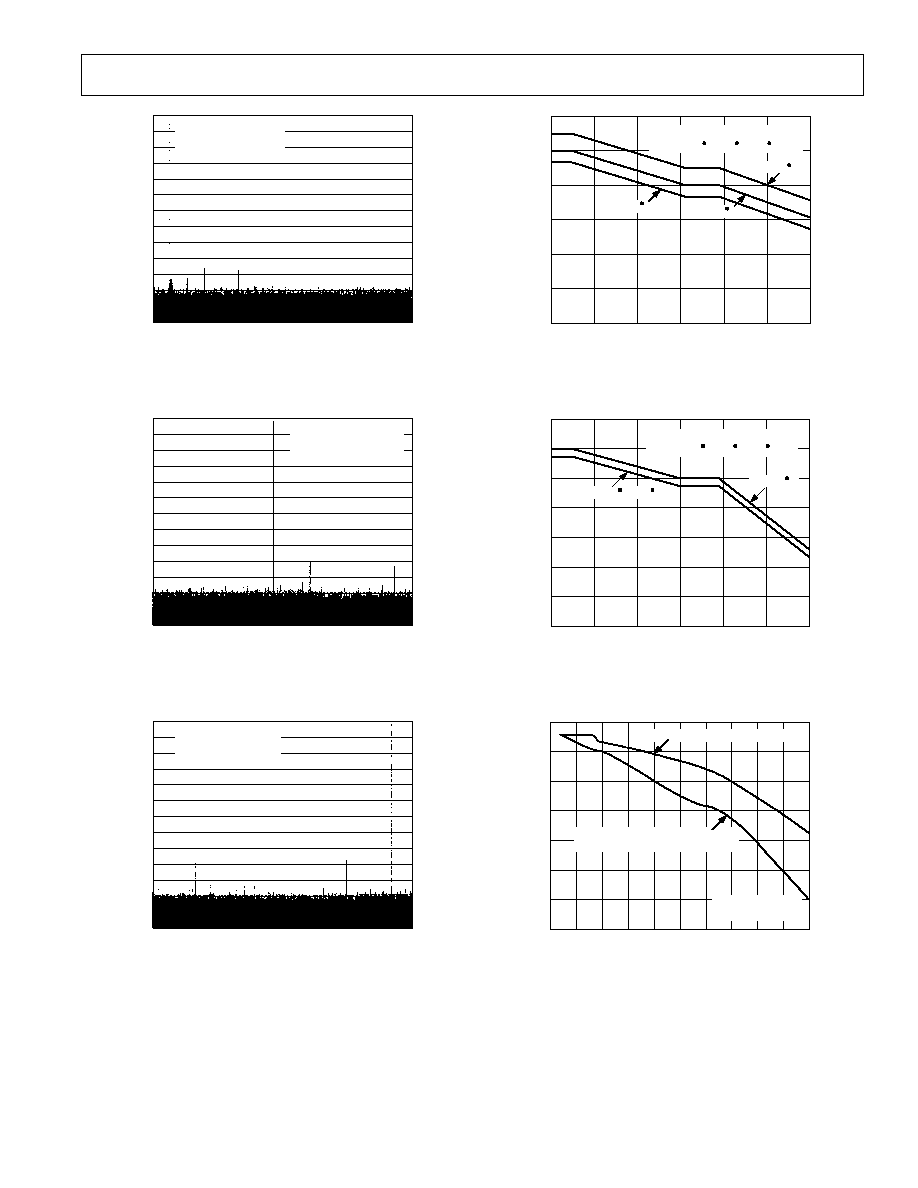
AD6644
9
REV. 0
Typical Performance Characteristics
FREQUENCY MHz
0
120
0
5
10
15
20
130
25
30
110
100
90
80
70
60
50
40
30
20
10
ENCODE = 65MSPS
AIN = 2.2MHz @ 1dBFS
SNR = 74.5dB
SFDR = 92dBc
Figure 8. Single Tone at 2.2 MHz
FREQUENCY MHz
0
120
0
5
10
15
20
130
25
30
110
100
90
80
70
60
50
40
30
20
10
ENCODE = 65MSPS
AIN = 15.5MHz @ 1dBFS
SNR = 74dB
SFDR = 90dBc
Figure 9. Single Tone at 15.5 MHz
FREQUENCY MHz
0
120
0
5
10
15
20
130
25
30
110
100
90
80
70
60
50
40
30
20
10
ENCODE = 65MSPS
AIN = 30MHz @ 1dBFS
SNR = 73.5dB
SFDR = 85dBc
Figure 10. Single Tone at 30 MHz
FREQUENCY MHz
0
30
SNR
dB
5
10
15
20
25
74.5
73.5
72.5
72.0
74.0
T = 25 C
T = 25 C
73.0
75.0
ENCODE = 65MSPS, AIN = 1dBFS
TEMP = 25 C, 25 C, 85 C
T = 85 C
Figure 11. Noise vs. Analog Frequency (Nyquist)
ANALOG INPUT FREQUENCY MHz
0
30
WORST-CASE HARMONIC
dBc
5
10
15
20
25
92
86
82
80
90
T = 25 C
T = 25 C, 85 C
ENCODE = 65MSPS, AIN = 1dBFS
TEMP = 25 C, 25 C, 85 C
84
88
94
Figure 12. Harmonics vs. Analog Frequency (Nyquist)
ANALOG FREQUENCY MHz
0
100
SNR
dB
10
20
50
70
80
74
71
69
68
73
70
72
75
30
40
60
90
AIN = 1dBFS
ENCODE = 65MSPS
PHASE NOISE OF ANALOG SOURCE
DEGRADES PERFORMANCE
LOW NOISE ANALOG SOURCE
Figure 13. Noise vs. Analog Frequency (IF)

AD6644
10
REV. 0
HARMONICS (2
nd
, 3
rd
)
ANALOG FREQUENCY MHz
0
100
HARMONICS
dBc
10
20
50
70
80
95
75
60
55
85
65
80
100
30
40
60
90
70
90
WORST OTHER SPUR
ENCODE = 65MSPS
AIN = 1dBFS
Figure 14. Harmonics vs. Analog Frequency (IF)
ANALOG INPUT POWER LEVEL dBFS
80
0
WORST-CASE SPURIOUS
dBFS and dBc
70
40
20
10
100
50
10
0
90
40
70
120
60
50
30
20
30
60
80
110
SFDR = 90dB
REFERENCE LINE
ENCODE = 65MSPS
AIN = 15.5MHz
dBc
dBFS
Figure 15. Single Tone SFDR
FREQUENCY MHz
0
120
0
5
10
15
20
130
25
30
110
100
90
80
70
60
50
40
30
20
10
ENCODE = 65MSPS
AIN = 19MHz,
19.5MHz @ 7dBFS
NO DITHER
Figure 16. Two Tones at 19 MHz and 19.5 MHz
FREQUENCY MHz
0
120
0
5
10
15
20
130
25
30
110
100
90
80
70
60
50
40
30
20
10
ENCODE = 65MSPS
AIN = 15MHz,
15.5MHz @ 7dBFS
NO DITHER
Figure 17. Two Tones at 15 MHz and 15.5 MHz
INPUT POWER LEVEL (F1 = F2) dBFS
77
7
WORST-CASE SPURIOUS
dBFS and dBc
67
27
17
100
50
10
0
90
40
70
57
47
37
20
30
60
80
110
ENCODE = 65MSPS
F1 = 15MHz
F2 = 15.5MHz
SFDR = 90dB
REFERENCE LINE
dBFS
dBc
Figure 18. Two-Tone SFDR
ENCODE FREQUENCY MHz
0
SNR, WORST SPURIOUS
dB and dBc
10
60
70
65
60
95
75
85
20
40
50
70
80
90
100
WORST SPUR
SNR
30
80
90
AIN = 2.2MHz @ 1dBFS
Figure 19. SNR, Worst Spurious vs. Encode
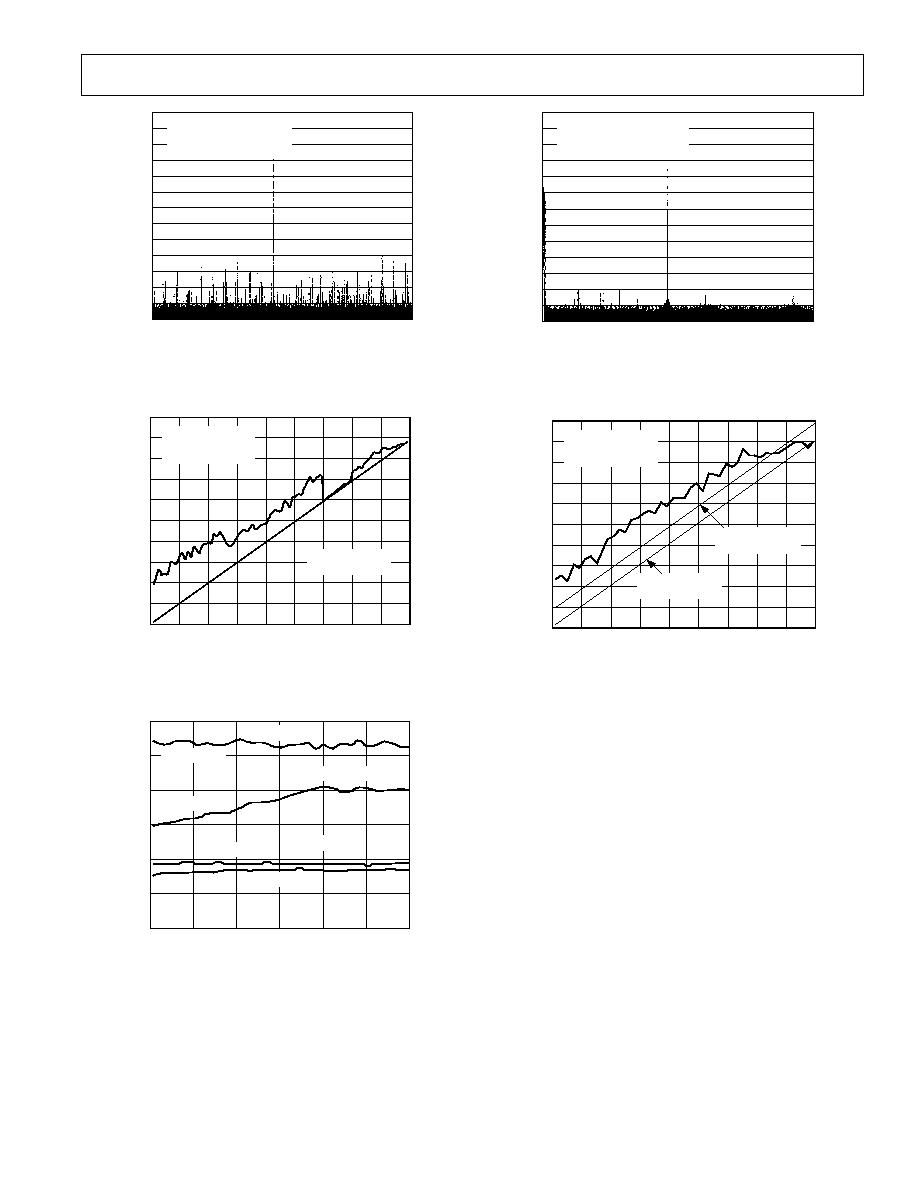
AD6644
11
REV. 0
FREQUENCY MHz
0
120
0
5
10
15
20
130
25
30
110
100
90
80
70
60
50
40
30
20
10
ENCODE = 65MSPS
AIN = 15.5MHz @ 29.5dBFS
NO DITHER
Figure 20. 1M FFT Without Dither
90
0
WORST-CASE SPURIOUS
dBc
80
30
10
90
50
10
0
40
70
70
50
40
20
30
60
80
100
ENCODE = 65MSPS
AIN = 15.5MHz
NO DITHER
60
20
ANALOG INPUT POWER LEVEL dBFS
SFDR = 90dB
REFERENCE LINE
Figure 21. SFDR Without Dither
ENCODE = 65MSPS
30.5MHz
ENCODE INPUT POWER dBm
15.0
15.0
SNR, WORST SPURIOUS
dB and dBc
10.0
0
5.0
80
70
65
85
95
5.0
10.0
75
WORST SPUR
90
2.2MHz
2.2MHz
30.5MHz
SNR
Figure 22. SNR, Worst Spurious vs. Clamped Encode
Power (See Figure 25)
FREQUENCY MHz
0
120
0
5
10
15
20
130
25
30
110
100
90
80
70
60
50
40
30
20
10
ENCODE = 65MSPS
AIN = 15.5MHz @ 29.5dBFS
DITHER @ 19dBm
Figure 23. 1M FFT with Dither
90
0
WORST-CASE SPURIOUS
dBc
80
30
10
90
50
10
0
40
70
70
50
40
20
30
60
80
100
ENCODE = 65MSPS
AIN = 15.5MHz
DITHER = 19dBm
60
20
ANALOG INPUT POWER LEVEL dBFS
SFDR = 90dB
REFERENCE LINE
SFDR = 100dB
REFERENCE LINE
Figure 24. SFDR with Dither

AD6644
12
REV. 0
THEORY OF OPERATION
The AD6644 analog-to-digital converter (ADC) employs a three
stage subrange architecture. This design approach achieves the
required accuracy and speed while maintaining low power and
small die size.
As shown in the functional block diagram, the AD6644 has
complementary analog input pins, AIN and AIN . Each analog
input is centered at 2.4 V and should swing
± 0.55 V around
this reference (Figure 2). Since AIN and AIN are 180 degrees
out of phase, the differential analog input signal is 2.2 V peak-
to-peak.
Both analog inputs are buffered prior to the first track-and-hold,
TH1. The high state of the ENCODE pulse places TH1 in hold
mode. The held value of TH1 is applied to the input of a 5-bit
coarse ADC1. The digital output of ADC1 drives a 5-bit digital-
to-analog converter, DAC1. DAC1 requires 14 bits of precision
which is achieved through laser trimming. The output of DAC1
is subtracted from the delayed analog signal at the input of TH3
to generate a first residue signal. TH2 provides an analog pipe-
line delay to compensate for the digital delay of ADC1.
The first residue signal is applied to a second conversion stage
consisting of a 5-bit ADC2, 5-bit DAC2, and pipeline TH4.
The second DAC requires 10 bits of precision which is met by
the process with no trim. The input to TH5 is a second residue
signal generated by subtracting the quantized output of DAC2
from the first residue signal held by TH4. TH5 drives a final
6-bit ADC3.
The digital outputs from ADC1, ADC2, and ADC3 are added
together and corrected in the digital error correction logic to
generate the final output data. The result is a 14-bit parallel
digital CMOS-compatible word, coded as two's complement.
APPLYING THE AD6644
Encoding the AD6644
The AD6644 encode signal must be a high quality, extremely low
phase noise source to prevent degradation of performance. Main-
taining 14-bit accuracy places a premium on encode clock phase
noise. SNR performance can easily degrade by 3 dB to 4 dB
with 70 MHz input signals when using a high-jitter clock source.
See Analog Devices' Application Note AN-501, "Aperture Uncer-
tainty and ADC System Performance" for complete details.
For optimum performance, the AD6644 must be clocked
differentially. The encode signal is usually ac-coupled into the
ENCODE and ENCODE pins via a transformer or capacitors.
These pins are biased internally and require no additional bias.
Shown below is one preferred method for clocking the AD6644.
The clock source (low jitter) is converted from single-ended to
differential using an RF transformer. The back-to-back Schottky
diodes across the transformer secondary limit clock excursions
into the AD6644 to approximately 0.8 V p-p differential. This
helps prevent the large voltage swings of the clock from feeding
through to the other portions of the AD6644, and limits the noise
presented to the ENCODE inputs. A crystal clock oscillator can
also be used to drive the RF transformer if an appropriate limiting
resistor (typically 100
) is placed in the series with the primary.
ENCODE
ENCODE
AD6644
T14T
HSMS2812
DIODES
CLOCK
SOURCE
0.1 F
100
Figure 25. Crystal Clock Oscillator Differential Encode
If a low jitter ECL/PECL clock is available, another option is to
ac-couple a differential ECL/PECL signal to the encode input pins
as shown below. A device that offers excellent jitter performance
is the MC100LVEL16 (or same family) from Motorola.
ENCODE
ENCODE
AD6644
0.1 F
0.1 F
VT
VT
ECL/
PECL
Figure 26. Differential ECL for Encode
Analog Input
As with most new high-speed, high dynamic range analog-to-
digital converters, the analog input to the AD6644 is differential.
Differential inputs allow much improvement in performance
on-chip as signals are processed through the analog stages. Most
of the improvement is a result of differential analog stages having
high rejection of even order harmonics. There are also benefits
at the PCB level. First, differential inputs have high common-
mode rejection to stray signals such as ground and power noise.
Also, they provide good rejection to common-mode signals such as
local oscillator feedthrough.
The AD6644 input voltage range is offset from ground by 2.4 V.
Each analog input connects through a 500
resistor to a 2.4 V
bias voltage and to the input of a differential buffer (Figure 2). The
resistor network on the input properly biases the followers for maxi-
mum linearity and range. Therefore, the analog source driving the
AD6644 should be ac-coupled to the input pins. Since the differ-
ential input impedance of the AD6644 is 1 k
, the analog input
power requirement is only 2 dBm, simplifying the driver amplifier
in many cases. To take full advantage of this high-input imped-
ance, a 20:1 transformer would be required. This is a large ratio
and could result in unsatisfactory performance. In this case, a
lower step-up ratio could be used. The recommended method for
driving the analog input of the AD6644 is to use a 4:1 RF trans-
former. For example, if R
T
were set to 60.4
and R
S
were set
to 25
, along with a 4:1 transformer, the input would match
to a 50
source with a full-scale drive of 4.8 dBm. Series resis-
tors (R
S
) on the secondary side of the transformer should be
used to isolate the transformer from A/D. This will limit the
amount of dynamic current from the A/D flowing back into
the secondary of the transformer. The terminating resistor (RT)
should be placed on the primary side of the transformer.
AIN
AIN
AD6644
T14T
ANALOG INPUT
SIGNAL
R
S
R
S
0.1 F
R
T
Figure 27. Transformer-Coupled Analog Input Circuit
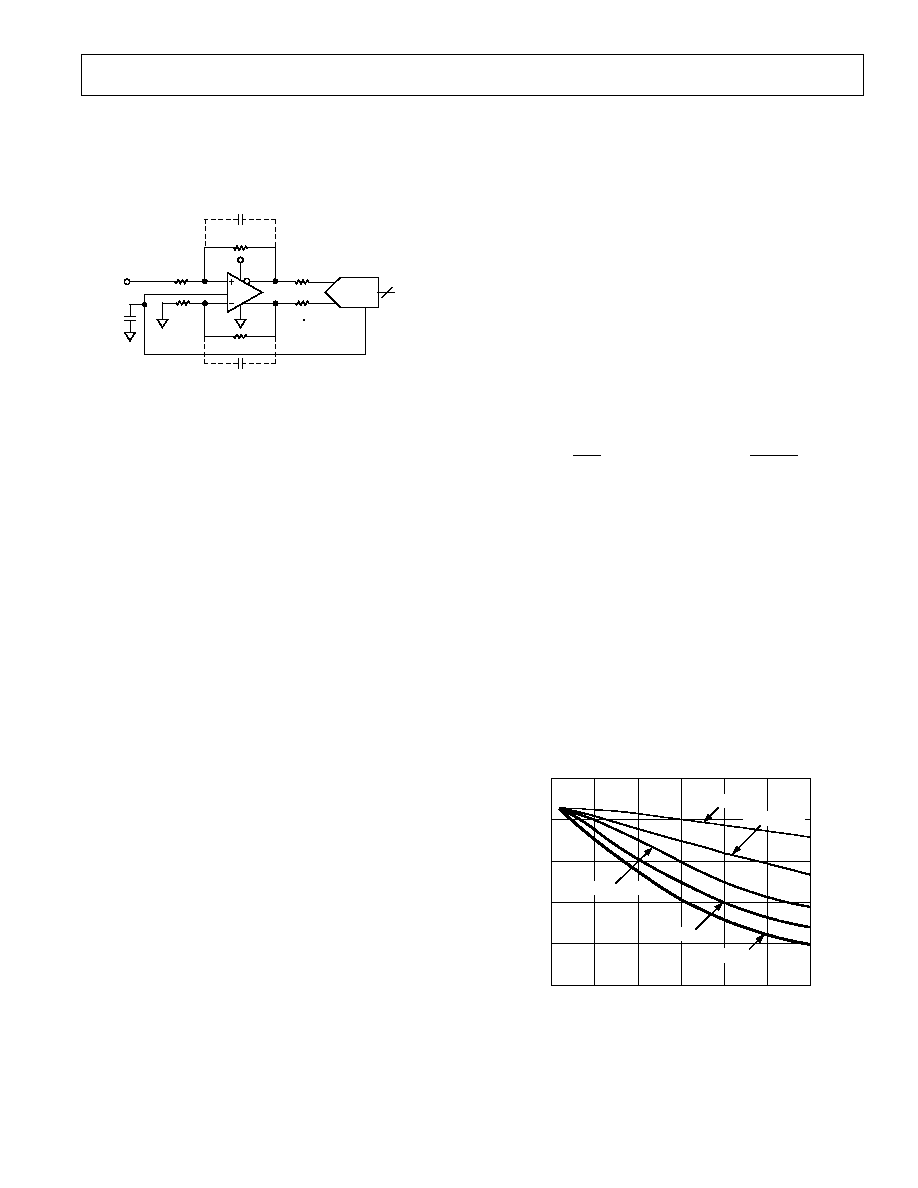
AD6644
13
REV. 0
In applications where dc-coupling is required, a new differential
output op amp from Analog Devices, the AD8138, can be used
to drive the AD6644 (Figure 28). The AD8138 op amp provides
single-ended-to-differential conversion, which reduces overall
system cost and minimizes layout requirements.
AD8138
C
F
499
AD6644
25
25
AIN
499
0.1 F
V
IN
499
499
5V
AIN
V
REF
DIGITAL
OUTPUTS
V
OCM
C
F
Figure 28. DC-Coupled Analog Input Circuit
Power Supplies
Care should be taken when selecting a power source. Linear
supplies are strongly recommended. Switching supplies tend to
have radiated components that may be "received" by the AD6644.
Each of the power supply pins should be decoupled as closely to
the package as possible using 0.1
µF chip capacitors.
The AD6644 has separate digital and analog power supply pins.
The analog supplies are denoted AV
CC
and the digital supply
pins are denoted DV
CC
. AV
CC
and DV
CC
should be separate
power supplies. This is because the fast digital output swings
can couple switching current back into the analog supplies. Note
that AV
CC
must be held within 5% of 5 V. The AD6644 is speci-
fied for DV
CC
= 3.3 V as this is a common supply for digital ASICs.
Output Loading
Care must be taken when designing the data receivers for the
AD6644. It is recommended that the digital outputs drive a
series resistor (e.g. 100
) followed by a gate like 74LCX574.
To minimize capacitive loading, there should only be one gate
on each output pin. An example of this is shown in the evaluation
board schematic shown in Figure 30. The digital outputs of the
AD6644 have a constant output slew rate of 1 V/ns. A typical
CMOS gate combined with a PCB trace will have a load of
approximately 10 pF. Therefore, as each bit switches, 10 mA
(10 pF 1 V 1 ns) of dynamic current per bit will flow in or out
of the device. A full scale transition can cause up to 140 mA
(14 bits 10 mA/bit) of current to flow through the output stages.
The series resistors should be placed as close to the AD6644 as
possible to limit the amount of current that can flow into the out-
put stage. These switching currents are confined between ground
and the DV
CC
pin. Standard TTL gates should be avoided since
they can appreciably add to the dynamic switching currents of
the AD6644. It should also be noted that extra capacitive loading
will increase output timing and invalidate timing specifications.
Digital output timing is guaranteed with 10 pF loads.
Layout Information
The schematic of the evaluation board (Figure 30) represents a
typical implementation of the AD6644. A multilayer board is
recommended to achieve the best results. It is highly recom-
mended that high-quality, ceramic chip capacitors be used to
decouple each supply pin to ground directly at the device. The
pinout of the AD6644 facilitates ease of use in the implementa-
tion of high frequency, high resolution design practices. All of
the digital outputs are segregated to two sides of the chip, with
the inputs on the opposite side for isolation purposes.
Care should be taken when routing the digital output traces.
To prevent coupling through the digital outputs into the analog
portion of the AD6644, minimal capacitive loading should be
placed on these outputs. It is recommended that a fan-out of
only one gate be used for all AD6644 digital outputs.
The layout of the Encode circuit is equally critical. Any noise
received on this circuitry will result in corruption in the digi-
tization process and lower overall performance. The Encode clock
must be isolated from the digital outputs and the analog inputs.
Jitter Considerations
The signal-to-noise ratio (SNR) for an ADC can be predicted.
When normalized to ADC codes, Equation 1 accurately predicts
the SNR based on three terms. These are jitter, average DNL
error, and thermal noise. Each of these terms contributes to the
noise within the converter.
SNR
f
t
V
N
ANALOG
RMS
NOISE RMS
N
=
×
+
+ × ×
×
+
log
(
)
(
)
/
20
1
2
2
2
2
2
2
1 2
J
(1)
f
ANALOG
= analog input frequency.
t
J RMS
= rms jitter of the encode (rms sum of encode
source and internal encode circuitry).
= average DNL of the ADC (typically 0.41 LSB).
N
= Number of bits in the ADC.
V
NOISE RMS
= V rms thermal noise referred to the analog input
of the ADC (typically 2.5 LSB).
For a 14-bit analog-to-digital converter like the AD6644, aper-
ture jitter can greatly affect the SNR performance as the analog
frequency is increased. The chart below shows a family of curves
that demonstrates the expected SNR performance of the AD6644
as jitter increases. The chart is derived from the above equation.
For a complete discussion of aperture jitter, please consult
Analog Devices' Application Note AN-501, "Aperture
Uncertainty and ADC System Performance."
JITTER ps
0
SNR
dB
0.1
55
0.2
0.3
0.4
0.5
0.6
60
65
70
75
80
AIN = 190MHz
AIN = 150MHz
AIN = 110MHz
AIN = 30MHz
AIN = 70MHz
Figure 29. SNR vs. Jitter

AD6644
14
REV. 0
AD6644ST/PCB Bill of Material
Item
Quantity
Reference
Description
1
2
C1, C2
Tantalum Chip Capacitor 10
µF
2
19
C3, C7, C8, C9, C10, C11, C16, C30, C31,
Ceramic Chip Capacitor 0508, 0.1
µF
C32, C4, C22, C23, C24, C25, C26, C27,
C28, C29
3
8
C12, C13, C14, C17, C18, C19, C20, C21
Ceramic Chip Capacitor 0508, 0.01
µF
4
1
CR1
HSMS2812 Surface Mount Diode
5
1
E3, E4, E5
3-Pin Header
6
4
F1, F2, F3, F4
Ferrite (Optional)
7
2
J1, J6
PCTB2
8
1
J2
50-Pin Double Row Header
9
1
J3
SMA Connector
10
2
J4, J5
BNC Connector
11
1
R1
Surface-Mount Resistor 1206, 100
12
1
R2
Surface-Mount Resistor 1206, 60.4
13
4
R3, R4, R5, R8
Surface-Mount Resistor 0805, 499
(Optional,
DC-Coupling Only)
14
2
R6, R7
Surface-Mount Resistor 0805, 25
15
1
R9
Surface-Mount Resistor 0805, 348
16
1
R10
Surface-Mount Resistor 0805, 615
17
1
R35
Surface-Mount Resistor 0805, 49.9
18
30
R36, R37, R38, R39, R40, R41, R42, R43,
Surface-Mount Resistor 0402, 100
R44, R45, R46, R47, R48, R49, R50, R51,
R52, R53, R54, R55, R56, R57, R58, R59,
R60, R61, R62, R63, R64, R65
19
2
T2, T3
Surface-Mount Transformer Mini-Circuits T41, 1:4 Ratio
20
1
U1
AD6644AST 14-Bit 65 MSPS A/D Converter
21
2
U2, U7
74LCX574 Octal Latch
22
1
U3
AD8138 Single-to-Differential Amplifier (Optional DC
Coupling Only)
23
2
U4, U6
NC7SZ32 Two Input OR Gate
24
1
U5
CTS Reeves Full-Size MX045 Crystal Clock Oscillator
EVALUATION BOARD
The evaluation board for the AD6644 is straightforward,
containing all required circuitry for evaluating the device. The
only external connections required are power supplies, clock,
and the analog inputs. The evaluation board includes the option
for an onboard clock oscillator for ENCODE.
Power to the analog supply pins of the AD6644 is connected via
the power terminal block (PCTB2). Power for the digital interface
is supplied via pin 1 of J6. The J2 connector mates directly with
SoftCell
Receive Signal Processor (AD6620, AD6624) evaluation
boards, allowing complete evaluation of system performance.
The analog input is connected via a BNC connector AIN, which
is transformer-coupled to the AD6644 inputs. The transformer
has a turns ratio of 1:4 to reduce the amount of input power
required to drive the AD6644.
The Encode signal may be generated using an onboard crystal
oscillator, U5. The on-board oscillator may be replaced by an
external encode source via the SMA connector labeled OPT_CLK
or BNC connector labeled ENCODE. If an external source is
used, it must be a high-quality and very low-phase noise source.
The AD6644 output data is latched using 74LCX574 (U7, U2)
latches. The clock for these latches is determined by selecting
jumper E3E4 or E4E5. E3 to E5 is a just a gate delayed ver-
sion of the clock, while connecting E4 to E5 utilizes the Data
Ready of the AD6644 to latch the output data. A clock is also
distributed with the output data (J2) that is labeled BUFLAT
(Pin 19 and 20, J2).
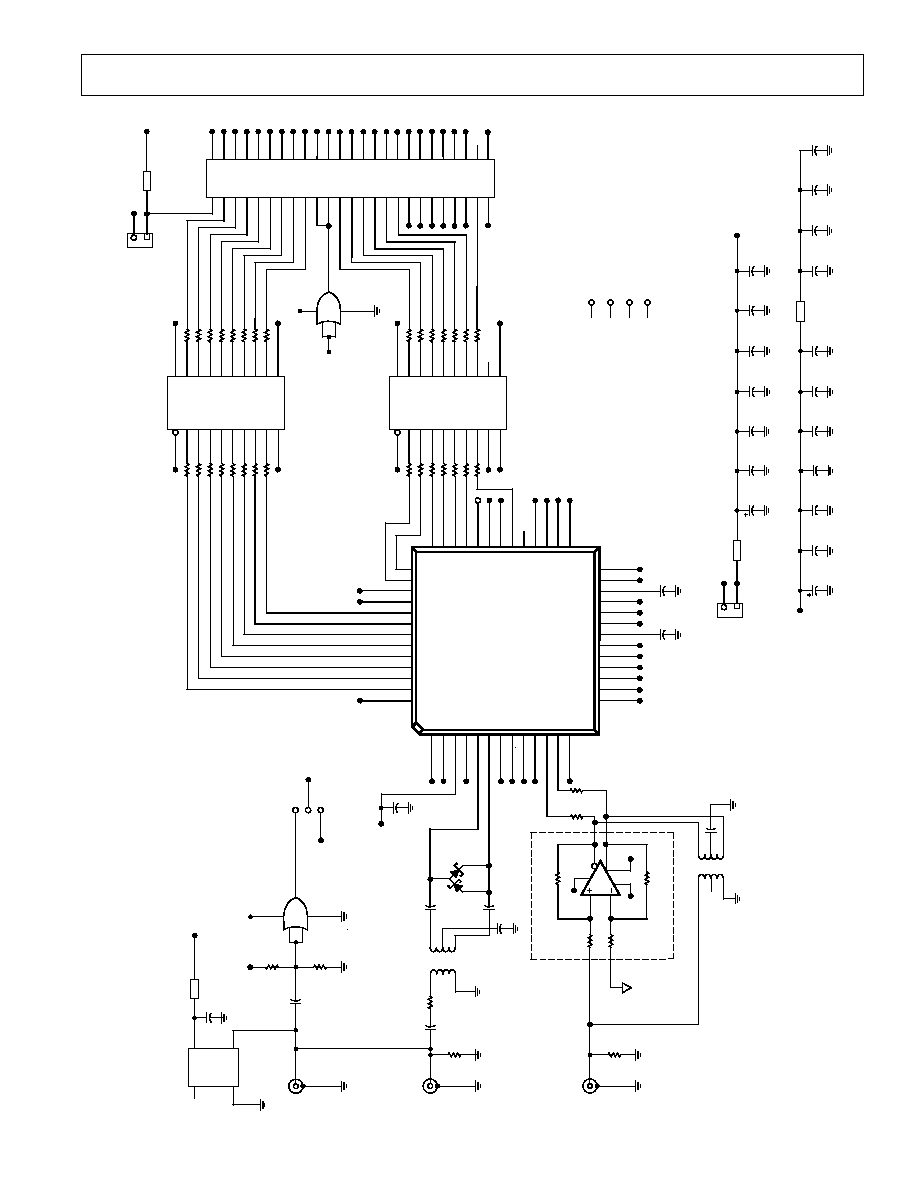
AD6644
15
REV. 0
OPT_CLK
J3
SMA
R9
348
R10
615
C3
100nF
3P3V
7
1
8
14
GND
NC
OUT
V
CC
U5
C22
100nF
1
F3
FERRITE
5VA
2
1
2
3
5
4
GND
V
U4
3P3VD
NC7SZ32
OPT_LAT
DR_OUT
BUFLAT
E4
E5
E3
K1115
GND
14
5VA
5VA
GND
5VA
GND
21
GND
C8
100nF
22
5VA
23
GND
24
GND
26
5VA
C7
100nF
AV
CC
GND
AV
CC
GND
AV
CC
GND
C1
GND
AV
CC
GND
C2
GND
AV
CC
15
16
17
18
19
20
25
AD6644ST
50
51
DR_OUT
49
48
47
45
44
43
3P3V
42
GND
52
46
41
40
29
5VA
27
28
GND
GND
30
5VA
31
32
33
34
GND
35
PREF
36
37
39
3P3V
38
11
AIN
13
12
GND
AIN
10
GND
9
8
6
5
4
3
1
GND
5VA
5VA
GND
GND
3P3V
DRY
D13
D12
D11
D10
D9
D8
D7
D6
DV
CC
GND
D5
D4
D3
D2
D1
D0
DMID
GND
DV
CC
OVR
DNC
AV
CC
GND
AV
CC
GND
2
7
DV
CC
GND
V
REF
GND
ENC
ENC
GND
AV
CC
AV
CC
GND
AIN
AIN
GND
100
4
R41
100
5
R40
100
6
R39
100
7
R38
100
8
R36
9
GND
10
GND
1
GND
100
3
R42
100
2
R43
OUT_EN
V
CC
D0
Q0
D1
Q1
D2
Q2
D3
Q3
D4
Q4
D5
Q5
D6
Q6
D7
Q7
GND
CLOCK
U2
74LCX574
5
4
AD8138
V
REF
2
6
GND
R4
499
3
U3
1
8
V
V
R8
499
T1
4T
5
6
4
T3
1:4
2
1
3
C30
100nF
R2
60.4
1
J5
2
BNC
R5
499
5VA
R3
499
AIN
R6
25
R7
25
ENC
ENC
2
1
3
CR1
C28
100nF
C27
100nF
1
2
3
C29
100nF
R35
49.9
1
ENC
J4
2
BNC
R1
100
6
4
C4
100nF
T2
T1
4T
1:4
HSMS2812
C32
100NF
V
REF
R61
17
100
R60
16
100
R59
15
100
R58
14
100
R37
13
100
12
11
BUFLAT
20
3P3VD
R62
18
100
R63
19
100
U1
OVR
B02
B03
B04
B05
GND
GND
GND
GND
GND
GND
GND
B00
B01
1
2
3
5
4
GND
V
U6
3P3VD
NC7SZ32
BUFLAT
B08
B07
B06
B10
B09
B11
B13
B12
100
4
R47
100
5
R48
100
6
R49
100
7
R50
100
8
R51
9
10
GND
1
GND
100
3
R46
100
2
R45
OUT_EN
V
CC
D0
Q0
D1
Q1
D2
Q2
D3
Q3
D4
Q4
D5
Q5
D6
Q6
D7
Q7
GND
CLOCK
U7
74LCX574
R53
17
100
R54
16
100
R55
15
100
R56
14
100
R57
13
100
12
11
BUFLAT
20
3P3VD
R52
18
100
R65
19
100
R64
100
100
R44
1
3
5
7
9
11
13
15
17
19
21
23
25
27
29
31
33
35
37
39
41
43
45
47
49
HEADR50
J2
2
4
6
8
10
12
14
16
18
20
22
24
26
28
30
32
34
36
38
40
42
44
46
48
50
GND
GND
GND
GND
GND
GND
GND
GND
GND
GND
GND
GND
GND
GND
GND
GND
GND
GND
GND
GND
GND
GND
GND
GND
1
F2
FERRITE
3P3V
2
1
2
GND
J6
PCTB2
1
F1
FERRITE
5VA
2
1
2
GND
J1
PCTB2
C2
10
F
C16
100nF
C17
10nF
C18
10nF
C19
10nF
C20
10nF
C21
10nF
C1
10
F
C9
100nF
C10
100nF
C11
100nF
C12
10nF
C13
10nF
C14
10nF
3P3V
1
F4
FERRITE
2
C23
100nF
C24
100nF
C25
100nF
C26
100nF
3P3VD
H1
H4
H3
H2
MOUNTING HOLES
NOTE: THE DOTTED LINE REPRESENTS AN OPTIONAL ANALOG DRIVE INPUT
Figure 30. AD6644ST/PCB Schematic (GS02357D Schematic)
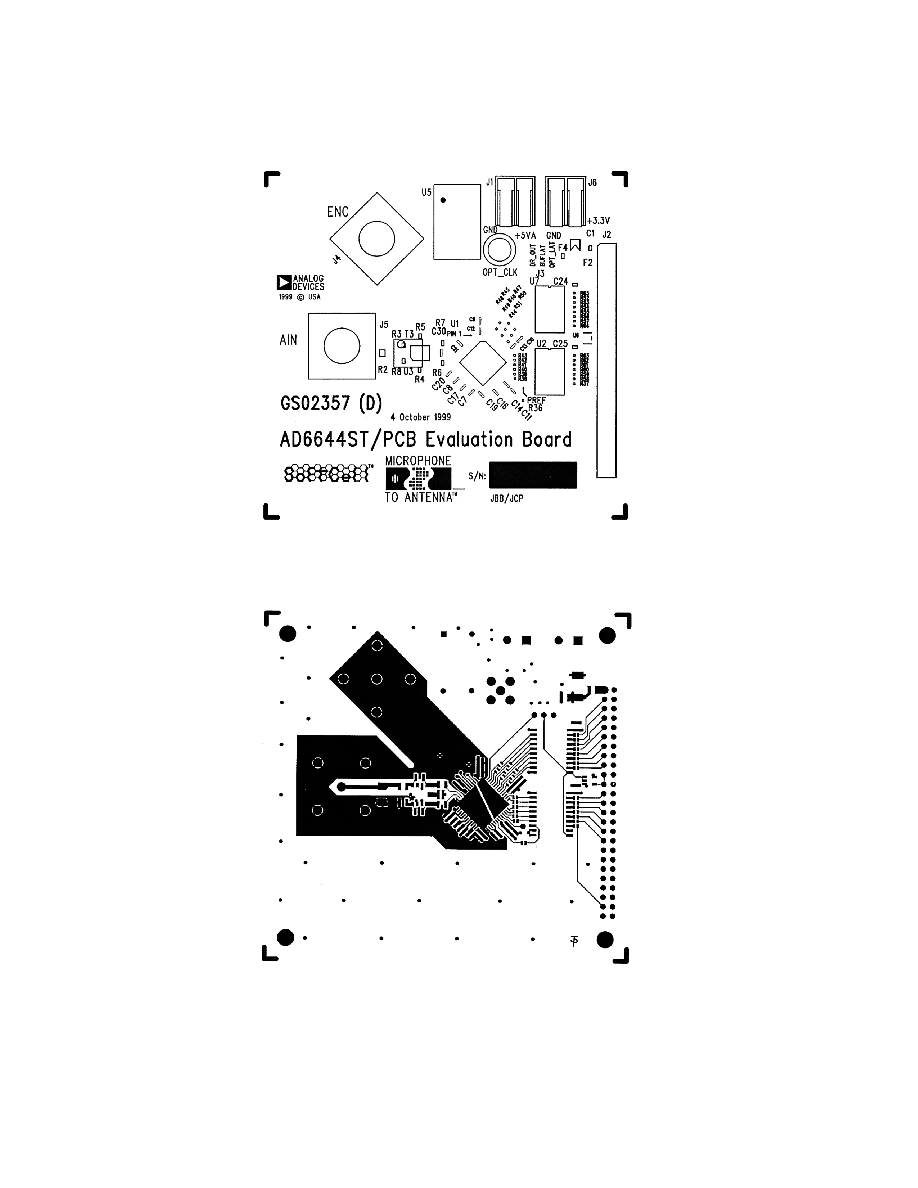
AD6644
16
REV. 0
Figure 31. AD6644ST/PCB Top Side Silkscreen
Figure 32. AD6644ST/PCB Top Side Copper
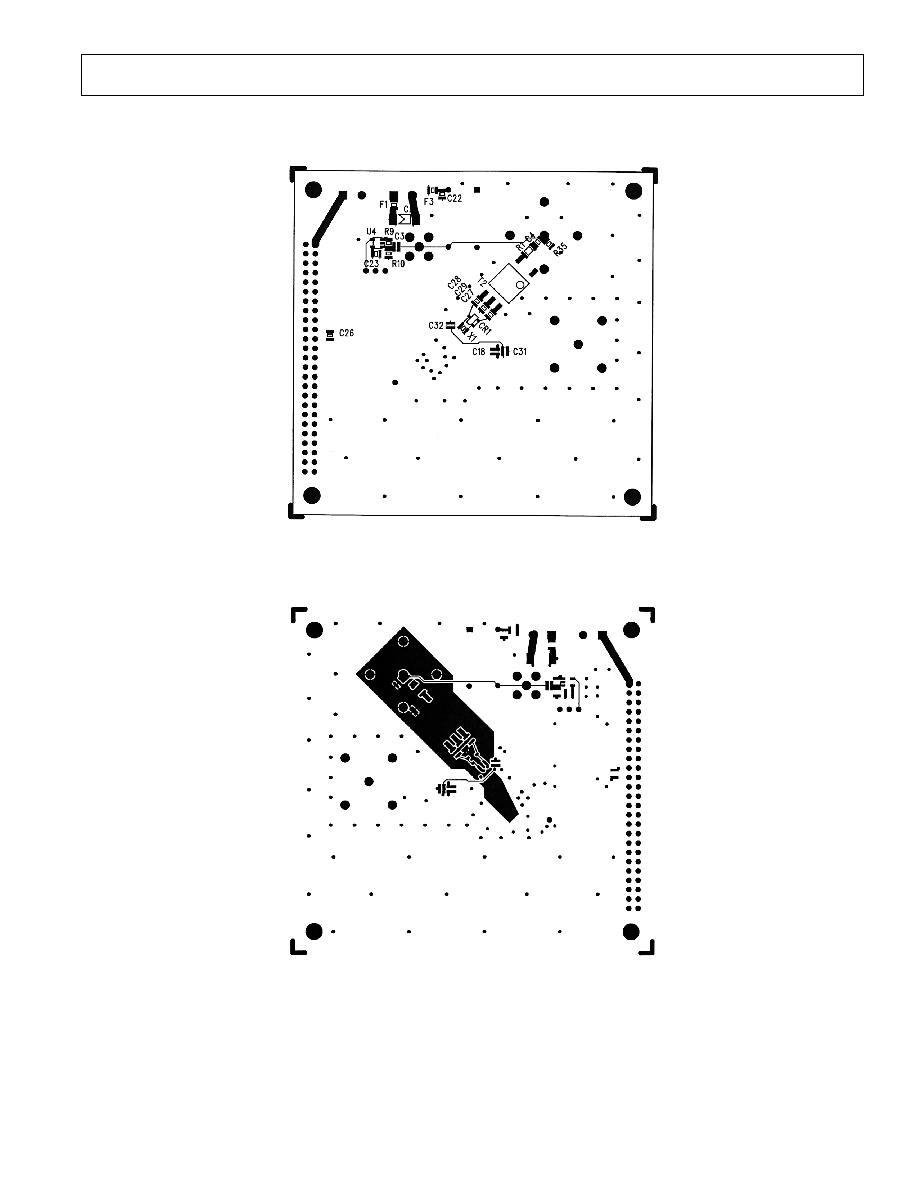
AD6644
17
REV. 0
Figure 33. AD6644ST/PCB Bottom Side Silkscreen
Figure 34. AD6644ST/PCB Bottom Side Copper
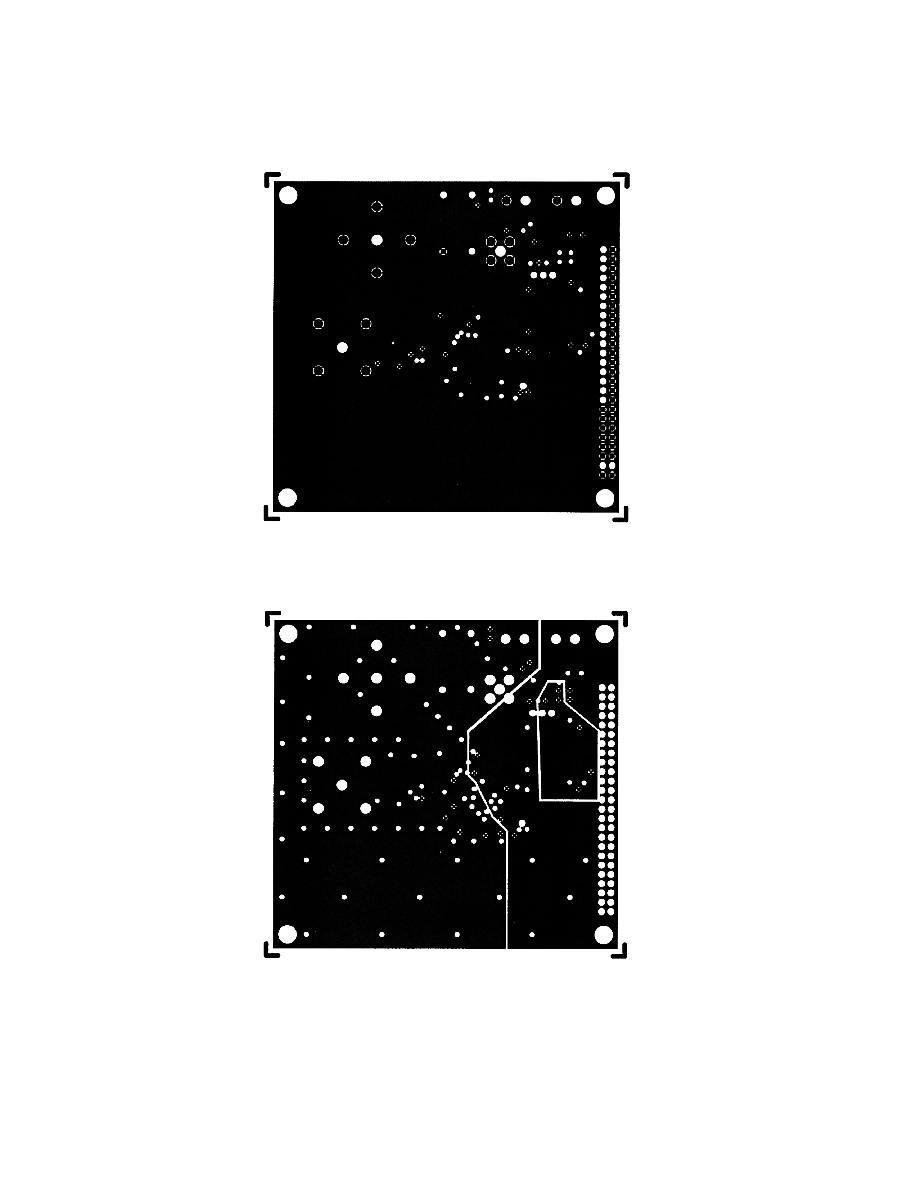
AD6644
18
REV. 0
Figure 35. AD6644ST/PCB Ground Layer Layers 2 and 5 (Negative)
Figure 36. AD6644ST/PCB "Split" Power Layer Layers 3 and 4 (Negative)

AD6644
19
REV. 0
OUTLINE DIMENSIONS
Dimensions shown in inches and (mm).
52-Terminal Plastic Low Profile Quad Flatpack
(ST-52)
TOP VIEW
(PINS DOWN)
40
52
1
14
13
26
27
39
0.026 (0.65)
BSC
0.472 (12.00) SQ
0.394
(10.0)
SQ
0.015 (0.38)
0.009 (0.22)
0.063 (1.60)
MAX
SEATING
PLANE
0.030 (0.75)
0.018 (0.45)
0.006 (0.15)
0.002 (0.05)
0.057 (1.45)
0.053 (1.35)
C3812
5
4/00 (rev. 0)
PRINTED IN U.S.A.


















